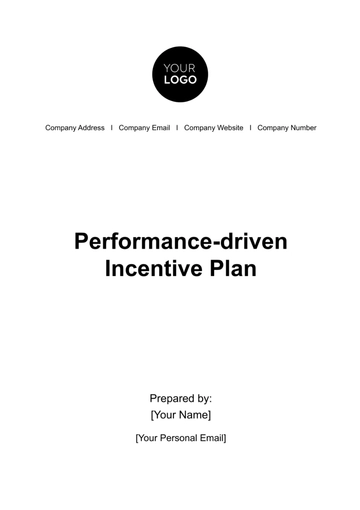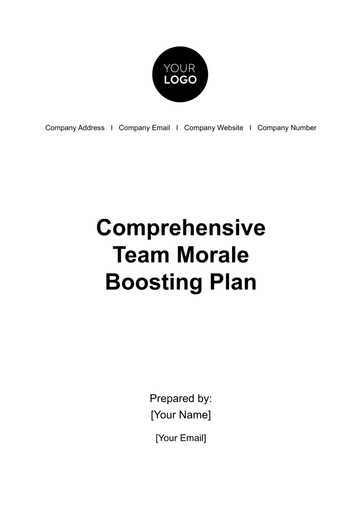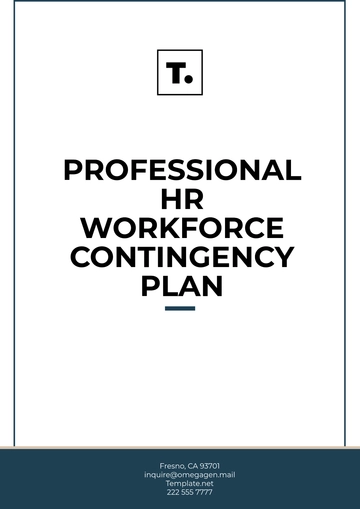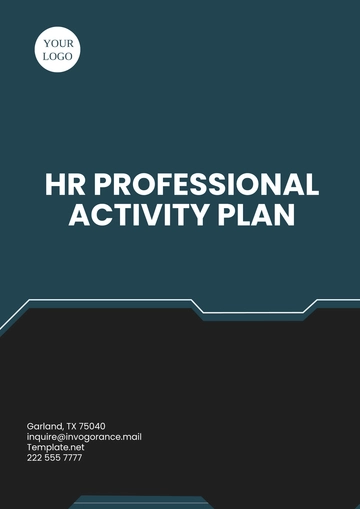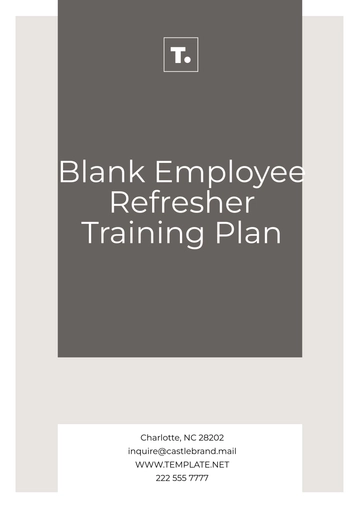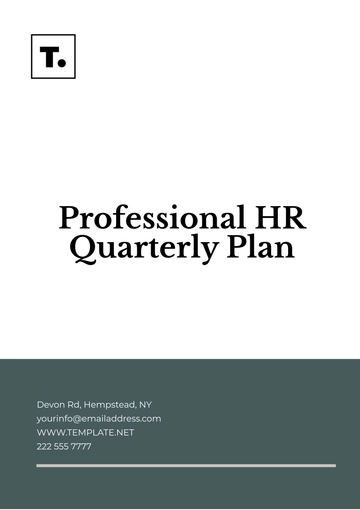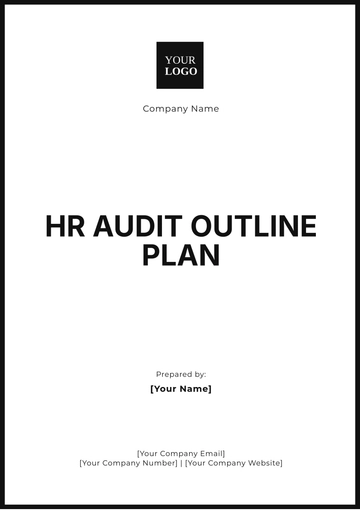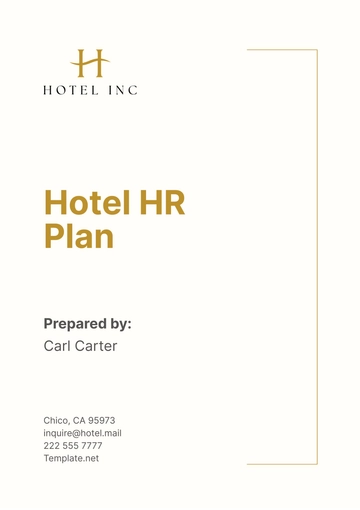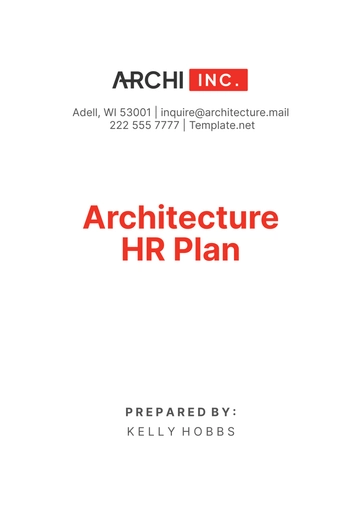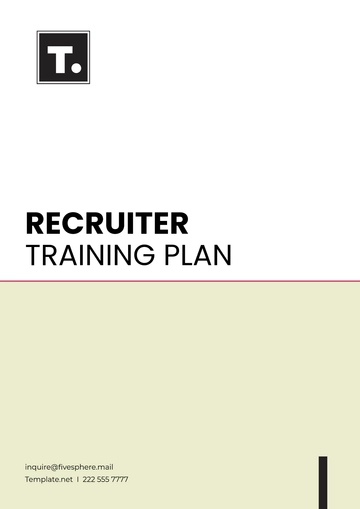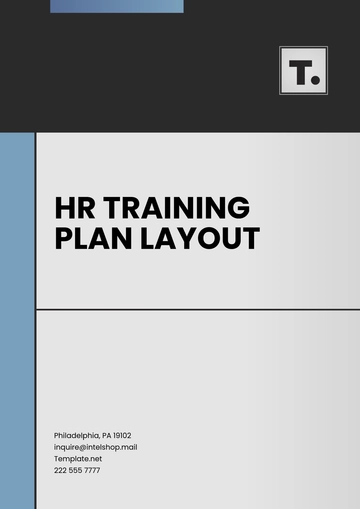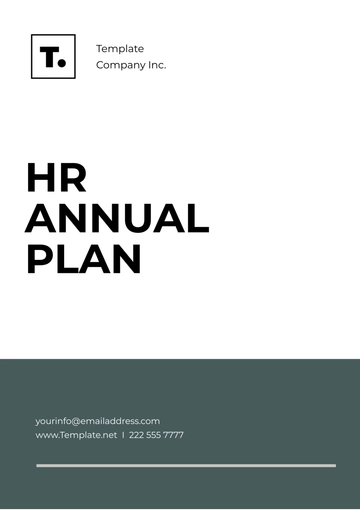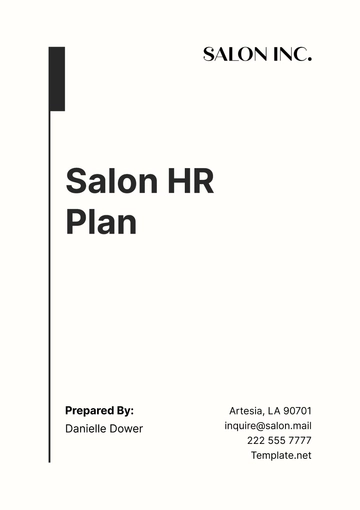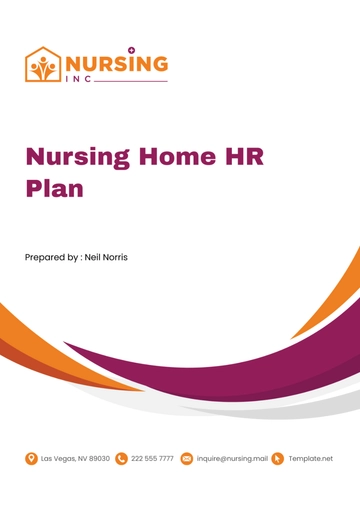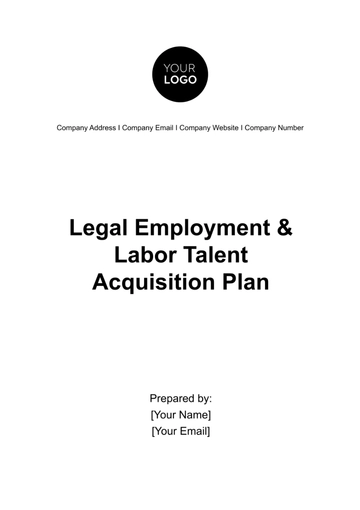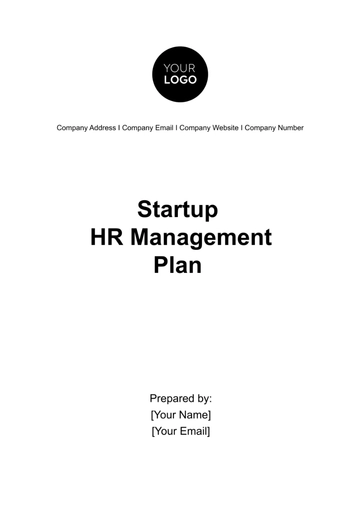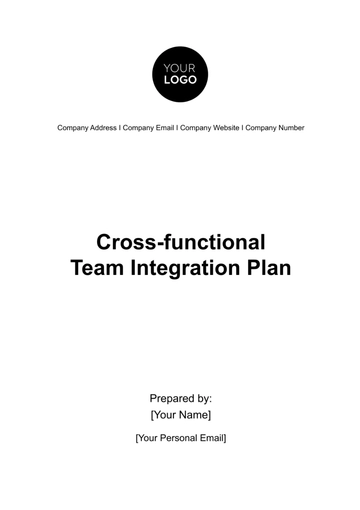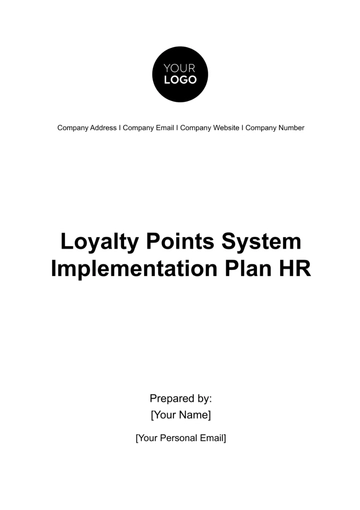Free Cross-functional Team Integration Plan HR
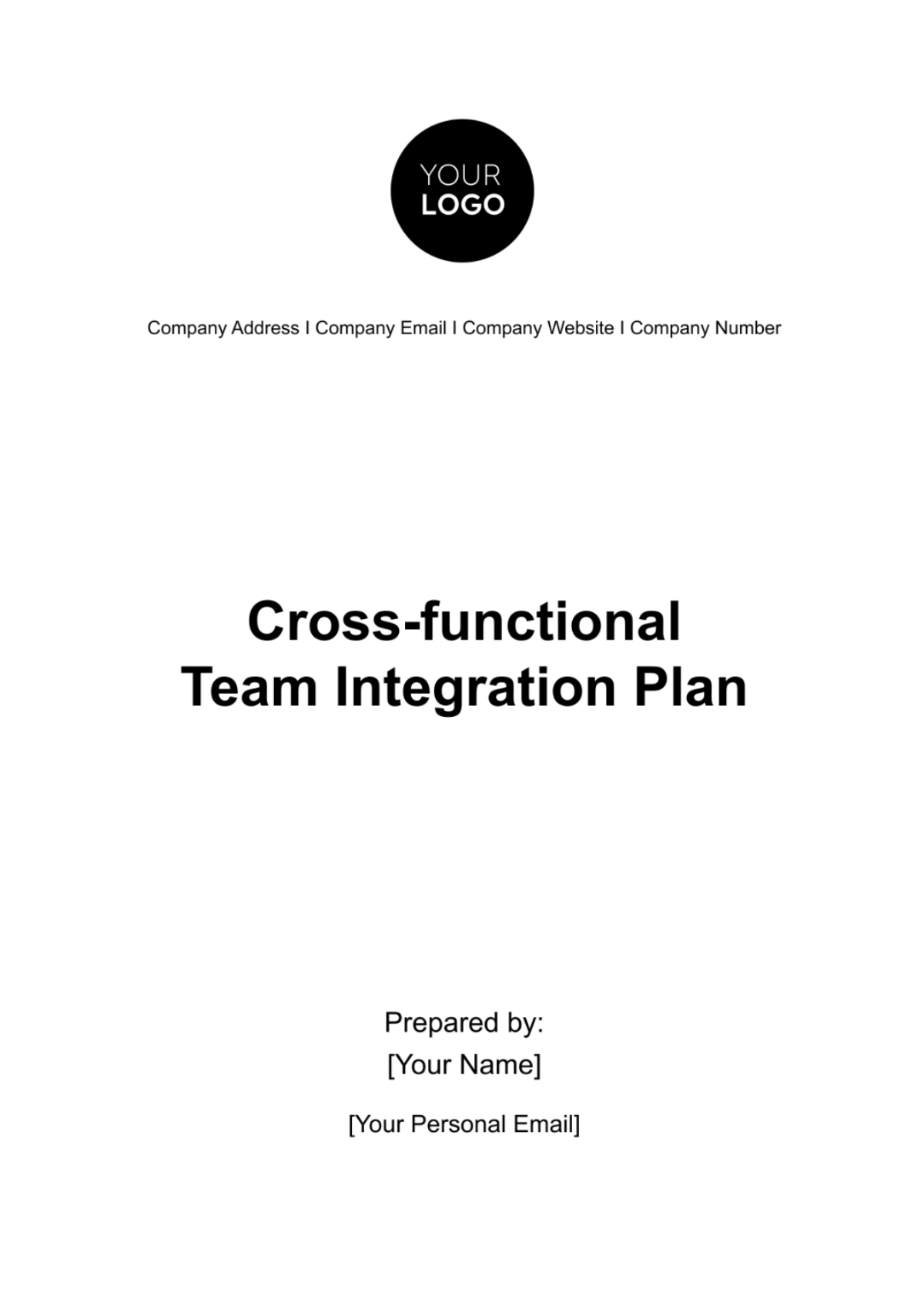
I. Introduction
A. Purpose of the Plan
The purpose of this plan is to facilitate seamless collaboration among various departments at [Your Company Name] to achieve our HR-related goals efficiently and effectively. It serves as a roadmap for integrating diverse talents and resources into HR initiatives.
B. Objectives of Cross-functional Team Integration
The primary objectives of this plan are to:
Enhance HR project outcomes through multi-disciplinary contributions.
Foster a culture of collaboration and knowledge sharing.
Ensure compliance with all US HR legal and standard guidelines.
Promote innovation and problem-solving by leveraging different perspectives.
C. Scope of the Plan
This plan encompasses the formation, execution, and evaluation of cross-functional teams involved in HR projects across [Your Company Name]. It applies to all HR-related initiatives that require collaboration beyond traditional HR boundaries.
D. Legal and Regulatory Compliance
[Your Company Name] is committed to adhering to all applicable US HR legal and regulatory requirements, including but not limited to Equal Employment Opportunity (EEO), Fair Labor Standards Act (FLSA), Americans with Disabilities Act (ADA), Occupational Safety and Health Administration (OSHA), and data privacy laws.
II. Team Formation
A. Identification of Key Stakeholders
Before forming the cross-functional team, it's crucial to identify key stakeholders who have a vested interest in the HR project at hand. These stakeholders may include:
Department heads
Senior management
Individuals affected by the project's outcomes
B. Selection of Team Members
HR Representatives: HR Representatives will form the core of the cross-functional team, providing expertise in HR policies, procedures, and best practices.
Representatives from Other Functional Areas: These individuals should possess skills, knowledge, and perspectives that are relevant to the project. This diversity encourages innovative solutions and a holistic approach.
Team Leader: The Team Leader's responsibilities include coordinating team efforts, managing timelines, and serving as the primary point of contact for communication within and outside the team.
C. Roles and Responsibilities Assignment
Each team member, including HR Representatives and members from other functional areas, will be provided with a detailed list of duties.
Team Member | Role | Responsibilities |
HR Representative | HR Expert |
|
III. Project Definition
A. Project Overview
The project overview provides a concise description of the HR initiative that the cross-functional team will be working on. This should include the project's purpose, its relevance to the organization's strategic goals, and any critical background information. It sets the stage for understanding why the project is necessary.
Project Overview The project aims to implement a comprehensive Employee Training and Development Program at [Your Company Name]. This initiative aligns with our strategic goal of fostering employee growth and enhancing organizational capabilities. It responds to the increasing demand for skill development and promotes a culture of continuous learning. |
Project Goals and Objectives Goal 1 Increase employee skill proficiency by 20% within the next year. Goal 2 Objective 1 Develop a customized training curriculum. Objective 2 |
Project Scope and Deliverables In Scope
Out of Scope
Deliverables
|
B. Timeline and Milestones
Provide a timeline for the project, including start and end dates. Identify key milestones and their corresponding dates to help the team and stakeholders track progress.
Project Start Date: June 15, 2053 | Project End Date: December 24, 2053 |
Milestones | |
| August 15, 2053 |
IV. Communication and Reporting
A. Communication Channels
Effective communication is vital for the success of cross-functional teams. The following communication channels will be utilized:
Meetings: Regular team meetings will be held to discuss project progress, address issues, and facilitate collaboration. Meetings will occur bi-weekly on the second and last Tuesdays of every month, 10 AM via Zoom Meeting.
Email Updates: Email will serve as a primary means for sharing updates, documents, and important information. Team members are expected to check their emails regularly for project-related communications.
Collaboration Tools: Slack will be used to facilitate real-time collaboration, document sharing, and task tracking. Training on these tools will be provided as needed.
B. Reporting Structure
A clear reporting structure ensures that project updates and information flow smoothly within the team and to relevant stakeholders. The reporting structure for this project is as follows:
C. Frequency of Updates
Regular updates are essential to keep all team members and stakeholders informed. The frequency of updates will be as follows:
Weekly progress reports will be shared during team meetings.
Email updates will be sent as needed to address urgent matters or share critical information.
D. Escalation Procedures
Escalation procedures are in place to address issues or challenges that may arise during the project. The following escalation path will be followed:
Level 1: Team members are encouraged to resolve minor issues collaboratively within the team.
Level 2: If issues persist or escalate, they will be escalated to the Team Leader, [Team Leader's Name], for resolution.
Level 3: In the case of unresolved disputes or significant project obstacles, the matter will be escalated to [Your Name] at [Your Company Email] for further guidance and resolution.
V. Resource Allocation
A. Budget Allocation
Proper budget allocation is crucial for the success of the project. The allocation is outlined below:
B. Technology and Tools
Presented below is the budget allocation for the technology and tools:
Technology and Tools | Budget Allocation |
Project Management Software | $6,000 |
Total |
C. Training and Skill Development
Training and skill development are essential components of this project to ensure that team members have the necessary knowledge and expertise to fulfill their roles effectively. Training will include:
HR Training
Functional Area Training
Training schedules and materials will be provided by the training coordinator.
D. Access to Subject Matter Experts
In the course of the project, access to subject matter experts (SMEs) may be required to provide guidance, insights, or specific knowledge related to HR or other functional areas. The project team will collaborate with SMEs as needed to address complex challenges or gather specialized information.
SMEs will be identified based on project requirements, and their involvement will be coordinated by the team leader.
VI. Conflict Resolution and Decision-Making
A. Conflict Identification and Resolution
Swiftly identifying and resolving conflicts is essential. Team members are encouraged to address minor issues collaboratively. Persistent conflicts will be escalated to the Team Leader for resolution.
B. Decision-Making Framework
Consensus-building is preferred. If consensus is unachievable, decisions will be made by a majority vote among team members, with the Team Leader holding the deciding vote if necessary.
C. Escalation Paths
Unresolved disputes or major obstacles will be escalated to [Your Name] at [Your Company Email] for guidance and resolution.
VII. Project Execution
In the execution phase, the project team will put the plan into action. This involves:
Task Execution
Monitoring and Progress Tracking
Risk Management
Quality Control
VIII. Metrics and Key Performance Indicators (KPIs)
A. Definition of Measurable KPIs
KPIs will serve as benchmarks to measure progress and outcomes. Examples of measurable KPIs may include improved employee engagement rates, training completion percentages, or mentorship program feedback scores.
B. Data Collection and Analysis
This includes setting up data collection processes, selecting appropriate data sources, and implementing data analysis tools and methods. Regular data reviews will be conducted to track project performance and identify trends or areas needing attention.
C. Performance Evaluation
Involves a systematic review of project progress against predefined KPIs. We will assess whether the project is meeting its goals and objectives, and identify areas for improvement. These evaluations will be conducted at regular intervals and will inform decision-making processes throughout the project's lifespan, ensuring that we stay on course to achieve our intended outcomes.
IX. Training and Development
A. Identify Skill Gaps
To ensure the success of our HR project, we will begin by identifying skill gaps among team members. This involves assessing the current skills and competencies of individuals and pinpointing areas where further development is needed.
B. Training Plans
Based on the identified skill gaps, we will develop tailored training plans. These plans will outline specific training modules, resources, and schedules for each team member. Training will be designed to address skill deficiencies and enhance overall project performance.
Team Member: Mica Rivers | Training Focus: HR Compliance |
Training Modules | |
Module 1
Module 2
| |
Training Schedule | |
Date | Activity |
June 1, 2052 | Start Module 1 |
B. Knowledge Sharing Initiatives
In addition to individual training, we will promote knowledge sharing initiatives within the team. This includes:
Regular knowledge-sharing sessions
Cross-training
Collaborative problem-solving
X. Evaluation and Adjustments
A. Ongoing Monitoring
Continuous monitoring is integral to the project's success. We will maintain ongoing oversight, tracking key performance indicators (KPIs), and regularly assessing progress. This allows us to promptly identify any deviations from the project plan, enabling quick corrective actions if necessary.
B. Continuous Improvement Initiatives
Embracing a culture of continuous improvement, we will actively seek ways to enhance project effectiveness. Team members will be encouraged to provide feedback and suggest improvements. Periodic reviews will identify areas for refinement, ensuring that our project remains aligned with organizational objectives and evolving best practices.
C. Plan Adjustments
Flexibility is key. If changes in project scope, goals, or external factors necessitate adjustments to the plan, we will evaluate and adapt accordingly. Clear communication channels will facilitate the flow of information, allowing for agile responses to changing circumstances while ensuring that project objectives are consistently met.
XI. Documentation
A. Meeting Minutes
Meeting minutes will be diligently recorded to document discussions, decisions, and action items from team meetings.
B. Progress Reports
Regular progress reports will be generated to provide a snapshot of project advancements. These reports summarize achievements, milestones, and any deviations from the project plan.
C. Issue Logs
Issue logs will be maintained to track and document any challenges or roadblocks encountered during the project. This documentation aids in issue resolution, root cause analysis, and process improvement.
XII. Project Closure
The project's closure begins with the verification of all deliverables against established criteria. A comprehensive final report will be prepared, summarizing the project's entire lifecycle, including achievements, challenges, and recommendations for future endeavors.
An evaluation of the project's success against predefined KPIs and objectives will be conducted. Lessons learned will be identified to celebrate successes and inform future improvements.
A smooth transition plan will be executed, including the handover of project assets, responsibilities, and documentation to relevant parties.
XIII. Legal and Compliance Considerations
A. Equal Employment Opportunity (EEO)
We commit to promoting a workplace free from discrimination and ensuring equal opportunities for all employees, regardless of race, color, religion, sex, or other protected characteristics.
B. Fair Labor Standards Act (FLSA)
This includes accurate classification of employees, proper wage and hour practices, and adherence to overtime and minimum wage standards.
C. Americans with Disabilities Act (ADA)
We will make reasonable accommodations for qualified individuals with disabilities and ensure accessibility in the workplace.
D. Occupational Safety and Health Administration (OSHA)
OSHA standards will be strictly observed to provide a safe and healthy working environment, preventing workplace accidents and illnesses.
E. Privacy and Data Protection (e.g., GDPR, CCPA)
Applicable privacy laws will be adhered to when handling employee data. We will ensure data protection, consent, and transparency in data processing practices.
F. Employment Contracts and Agreements
All employment contracts and agreements will be drafted in compliance with relevant labor laws, outlining terms and conditions that protect both employees and the organization.
XIV. Conclusion
In conclusion, this plan outlines our approach to project success through effective teamwork and collaboration. We extend our appreciation to all team members for their dedication and contributions, which are instrumental in achieving our goals.
- 100% Customizable, free editor
- Access 1 Million+ Templates, photo’s & graphics
- Download or share as a template
- Click and replace photos, graphics, text, backgrounds
- Resize, crop, AI write & more
- Access advanced editor
Foster collaboration with Template.net's versatile Cross-functional Team Integration Plan HR Template! This tool facilitates seamless integration. Leverage our advanced AI Editor Tool for precise adjustments, tailoring the integration plan to align with your organizational structure, goals, and promote cross-functional synergy. Never miss this editable and customizable solution! Try it out!
You may also like
- Finance Plan
- Construction Plan
- Sales Plan
- Development Plan
- Career Plan
- Budget Plan
- HR Plan
- Education Plan
- Transition Plan
- Work Plan
- Training Plan
- Communication Plan
- Operation Plan
- Health And Safety Plan
- Strategy Plan
- Professional Development Plan
- Advertising Plan
- Risk Management Plan
- Restaurant Plan
- School Plan
- Nursing Home Patient Care Plan
- Nursing Care Plan
- Plan Event
- Startup Plan
- Social Media Plan
- Staffing Plan
- Annual Plan
- Content Plan
- Payment Plan
- Implementation Plan
- Hotel Plan
- Workout Plan
- Accounting Plan
- Campaign Plan
- Essay Plan
- 30 60 90 Day Plan
- Research Plan
- Recruitment Plan
- 90 Day Plan
- Quarterly Plan
- Emergency Plan
- 5 Year Plan
- Gym Plan
- Personal Plan
- IT and Software Plan
- Treatment Plan
- Real Estate Plan
- Law Firm Plan
- Healthcare Plan
- Improvement Plan
- Media Plan
- 5 Year Business Plan
- Learning Plan
- Marketing Campaign Plan
- Travel Agency Plan
- Cleaning Services Plan
- Interior Design Plan
- Performance Plan
- PR Plan
- Birth Plan
- Life Plan
- SEO Plan
- Disaster Recovery Plan
- Continuity Plan
- Launch Plan
- Legal Plan
- Behavior Plan
- Performance Improvement Plan
- Salon Plan
- Security Plan
- Security Management Plan
- Employee Development Plan
- Quality Plan
- Service Improvement Plan
- Growth Plan
- Incident Response Plan
- Basketball Plan
- Emergency Action Plan
- Product Launch Plan
- Spa Plan
- Employee Training Plan
- Data Analysis Plan
- Employee Action Plan
- Territory Plan
- Audit Plan
- Classroom Plan
- Activity Plan
- Parenting Plan
- Care Plan
- Project Execution Plan
- Exercise Plan
- Internship Plan
- Software Development Plan
- Continuous Improvement Plan
- Leave Plan
- 90 Day Sales Plan
- Advertising Agency Plan
- Employee Transition Plan
- Smart Action Plan
- Workplace Safety Plan
- Behavior Change Plan
- Contingency Plan
- Continuity of Operations Plan
- Health Plan
- Quality Control Plan
- Self Plan
- Sports Development Plan
- Change Management Plan
- Ecommerce Plan
- Personal Financial Plan
- Process Improvement Plan
- 30-60-90 Day Sales Plan
- Crisis Management Plan
- Engagement Plan
- Execution Plan
- Pandemic Plan
- Quality Assurance Plan
- Service Continuity Plan
- Agile Project Plan
- Fundraising Plan
- Job Transition Plan
- Asset Maintenance Plan
- Maintenance Plan
- Software Test Plan
- Staff Training and Development Plan
- 3 Year Plan
- Brand Activation Plan
- Release Plan
- Resource Plan
- Risk Mitigation Plan
- Teacher Plan
- 30 60 90 Day Plan for New Manager
- Food Safety Plan
- Food Truck Plan
- Hiring Plan
- Quality Management Plan
- Wellness Plan
- Behavior Intervention Plan
- Bonus Plan
- Investment Plan
- Maternity Leave Plan
- Pandemic Response Plan
- Succession Planning
- Coaching Plan
- Configuration Management Plan
- Remote Work Plan
- Self Care Plan
- Teaching Plan
- 100-Day Plan
- HACCP Plan
- Student Plan
- Sustainability Plan
- 30 60 90 Day Plan for Interview
- Access Plan
- Site Specific Safety Plan
